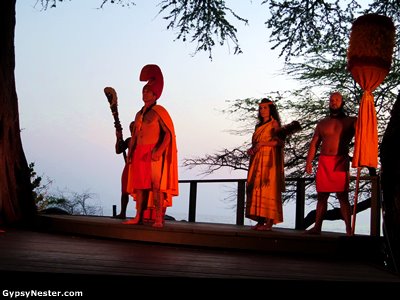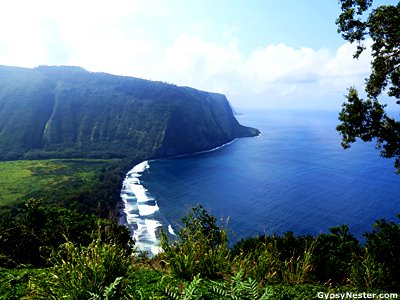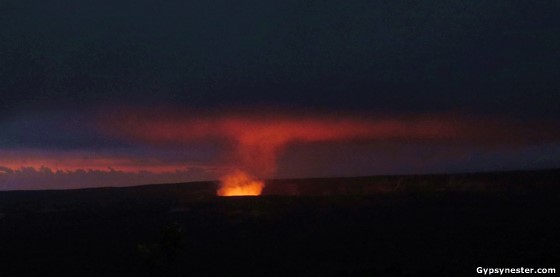
We have all seen the scenes of virgins being ceremoniously thrown into the gaping maw of an active volcano in some Late, Late Show Cinematic masterpiece. The gruesome ritual usually seems to involve grass skirts and coconut shell bras, indicating a Polynesian paradise gone awry.
Hawaii would be a perfect setting for this since the archipelago was formed by a string of volcanoes that have grown out of the sea. While it looks as though the source of these islands has moved southeast along the bottom of the sea, in reality, the opposite has occurred.

The ocean floor, which is part of the Pacific Plate in geology 101 tectonics lingo, has slowly slid over a stationary hotspot in the earth’s mantle at a rate of about thirty miles every million years which forms new land as it moves.
Over the past 85 million years this motion has created a chain of volcanic islands some 3,600 mi long.
The long extinct older ones have eroded away, disappearing under the surface of the sea as they pull away from the hotspot. This is why Hawai’i (the local spelling), the biggest and southernmost of the islands, is the only one with active volcanoes.
 This process has created the largest mountain on earth. So high in fact, that even in the heart of the tropics we saw the peak covered in snow as we flew in for our landing at the Kona airport.
This process has created the largest mountain on earth. So high in fact, that even in the heart of the tropics we saw the peak covered in snow as we flew in for our landing at the Kona airport.
Wait, what about Everest? Well, when Mauna Kea’s altitude of 13,796 feet above sea level is added to the 20,000 feet that it rises from the ocean floor below the water’s surface, it is easily the world’s biggest mount.
 The best place to see this incredible geologic activity in action is Volcanoes National Park. Oddly enough, although this is the newest state in the union, the park is one of the nation’s oldest, having been established in 1916 by President Woodrow Wilson.
The best place to see this incredible geologic activity in action is Volcanoes National Park. Oddly enough, although this is the newest state in the union, the park is one of the nation’s oldest, having been established in 1916 by President Woodrow Wilson.
Our initial focus was on getting to the summit of Kīlauea, one of the world’s most active volcanoes. The eruptions are so common that the name means spewing in the Hawaiian language, and lava has been flowing non-stop since 1983.
 From the observation deck at the Jaggar Museum we could see the Halema’uma’u Crater, which is basically a lake of liquid rock. The glowing, red-hot magma bubbled up into view through the smoke and we thought; this would be the perfect spot for an offering to Pele.
From the observation deck at the Jaggar Museum we could see the Halema’uma’u Crater, which is basically a lake of liquid rock. The glowing, red-hot magma bubbled up into view through the smoke and we thought; this would be the perfect spot for an offering to Pele.
The goddess of fire, lightning, wind, and volcanoes was believed to live in the caldera, but she must not have desired martyred maidens because by all accounts no one was ever tossed over the edge. That is a figment of some movie maker’s imagination.

That’s not to say that human sacrifices never happened, it was likely quite common in various places around the world, maybe even here in Hawaii, just that the method did not involve lobbing ladies into lava lakes.
Anyway, Pele’s wrath seems to have been pacified because the last time there was a violent, explosive eruption was more than two centuries ago. Maybe she’s happy that there are no sacrifices.
From our perch atop Kīlauea, we got a clear view of the crater and caught glimpses of luminous lava as it bubbled up over the edge from time to time. There is also a museum with explanations of the geologic processes and history of the volcano.
 It was here that we got to meet Pele in person, or at least a few artist’s renditions.
It was here that we got to meet Pele in person, or at least a few artist’s renditions.
After exploring the exhibits and taking another look out at the eruption, we moved across to the other side of the crater. The observation area here may not be as close, but it is much more comfortable and comes with a hotel and restaurant.
We were content with snacks and cocktails, so we settled in to watch the sunset through the giant windows facing the crater.
 The combination of darkening skies with the clouds illuminated by the glow of the molten rock was nothing short of spectacular. The fiery radiance of the red-hot magma lit the low hanging clouds in an eerie light show that rivaled any 70s rock concert.
The combination of darkening skies with the clouds illuminated by the glow of the molten rock was nothing short of spectacular. The fiery radiance of the red-hot magma lit the low hanging clouds in an eerie light show that rivaled any 70s rock concert.
We stayed put until total darkness, and then correctly supposed that the view from our previous post would be even more fantastic at night.
 We could hardly tear ourselves away from the scene, but knew we had to return to our earlier observation spot at the Jaggar Museum in hopes of seeing some spectacular nighttime live lava action in the crater.
We could hardly tear ourselves away from the scene, but knew we had to return to our earlier observation spot at the Jaggar Museum in hopes of seeing some spectacular nighttime live lava action in the crater.
 Our thinking was spot-on and the display did not disappoint. The pitch dark backdrop behind the molten pool made for much better viewing than our daylight visit and we, along with the several dozen other spectators, were completely mesmerized.
Our thinking was spot-on and the display did not disappoint. The pitch dark backdrop behind the molten pool made for much better viewing than our daylight visit and we, along with the several dozen other spectators, were completely mesmerized.
The incredible power that lies deep within our planet was on display only a few hundred yards away and yet we felt perfectly safe.
Must mean that Pele was peacefully appeased… even without a sacrifice.
David & Veronica, GypsyNester.com



Your website has superb content. I bookmarked the site
Hawai is absolutely stunning and you did an amazing job capturing its beauty! Now I really want to go back, but this time in the Winter with my family!
Thanks!
Wow! The views look amazing! Would love to visit some day! Great post!